|

Summer 2002 (10.2)
Pages
42-49
Stories of Taghiyev
Baku's
Most Renowned Oil Baron
by Manaf Suleymanov
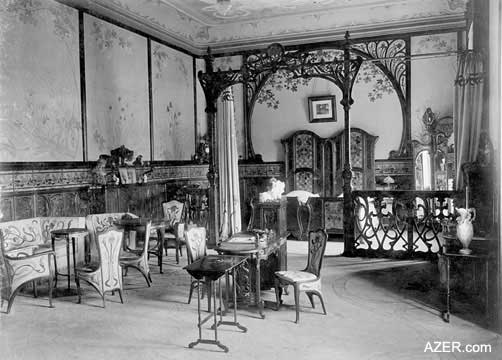
Above:
Taghiyev's Bedroom. His
palatial residence was constructed in 1895-1896. In 1920 when
the Bolsheviks took Baku, they confiscated all property. Taghiyev
fled to his summer home in Mardakan. Photo: Taghiyev's personal
album from the National History Museum (housed in his residence
in Baku).
Other articles related to Zeynalabdin
Taghiyev, Baku Oil Philanthropist:
(1) Legacy
of the Oil Barons by Fuad Akhundov (AI 2:2, Summer 1994)
(2) Just for Kids: The
ABCs of Baku (Monogram of Taghiyev) in (AI 6.4, Winter 1998)
(3) Quote: Education
of Women - Haji Zeynalabdin Taghiyev (AI 6:3, Autumn 1998)
(4) Quote: Written
Word Brings Happiness - Haji Zeynalabdin Taghiyev (AI 8:1,
Spring 2000)
(5) The
Taghiyev Museum (AI 8.2, Summer 2000)
(6) Baku's
Architecture - Identity of Architects and Financiers Revealed
(AI 9: 4, Winter 2001)
(7) Taghiyev's Commitment
to the Water Problem by Manaf Suleymanov (AI 10.2, Summer
2002)
(8) Baku's Search for Water:
A Brief Chronology by Mammad Mammadov (AI 10.2, Summer 2002)
______
The life of Haji Zeynalabdin
Taghiyev (pronounced TAH-gi-yev) is basically a story of rags
to riches and back to rags again. Various documents provide different
dates for the year of Haji Zeynalabdin Taghiyev's birth. Family members say that he was born in 1838 though rumors still circulate that his date of birth was 1821. [He died on September
1, 1924.]
As the son of a shoemaker, Taghiyev began his life in poverty
and had to work from childhood to support his family. At age
35, he bought a plot of land and lucked out when the oil started
to gush. Before long, Taghiyev was one of the wealthiest oil
barons in Baku. But once the Bolsheviks took control of Baku
in 1920, he was stripped of his wealth again.
Taghiyev is remembered not only for his great wealth, but how
he chose to spend it. As Baku's best-known philanthropist, he
contributed to countless endeavors, especially in the realms
of education, health and culture.
The vignettes that follow provide brief glimpses of Taghiyev's
life. They were compiled by the late Manaf Suleymanov (1913-2001),
who dared to publish them in 1987 in his book in Azeri entitled,
"What I Saw, What I Read, What I Heard" (Eshitdiklarim,
Okhuduglarim, Gorduklarim). The book quickly became a bestseller.
The Russian version, "Bygone Days" (Dni Minuvshiye)
followed in 1990, a year prior to the collapse of the Soviet
Union.
Suleymanov gleaned his stories from every source possible, so
their authenticity cannot always be ascertained. However, it
is remarkable that these stories managed even to survive at all
during Azerbaijan's 70 years of Soviet domination, when it was
considered risky even to mention the name of any Oil Baron. People
were even cautious of having a single photo of any of these pre-revolutionary
capitalists hidden in their apartments. Few Soviet-era history
books mention Taghiyev's name, even though he was an incredibly
important figure in Azerbaijan's business, cultural and educational
development.
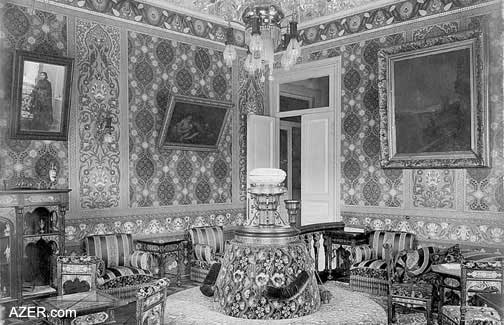
Above: The boudoir (private sitting room)
of Taghiyev's wife. All of the moveable furniture and paintings
in this room have disappeared. Nothing remains today except the
ornate mirrored mosaic ceiling. During the Soviet period, four
layers of white paint were applied over the original ornately
painted walls. Still in the main halls of the residence, the
original paint has withstood the passage of time incredibly well.
The paint was made of finely ground egg shell as was the practice
of artists of Byzantine icons. Nearly 100 years later, the original
colors with their subtlety and sophistication have neither faded
or chipped. Photo: Taghiyev's personal album from the National
History Museum (housed in his residence in Baku).
When reflecting upon his own life, Taghiyev reputedly said, "I
don't know how to explain it, but along with my industrial business,
I like to spend time, perhaps even more of my time, dealing with
various issues related to my people - their future happiness
and the continuation of my nation's existence. Conscious of how
much they need enlightenment and nurturing, I've tried to help
as much as I could."
______
From Manaf Suleymanov....
Taghiyev's father - the shoemaker
Taghi - was originally from the fortified part of Baku [Ichari
Shahar - "Inner City" or "Old City", as foreigners
usually call it]. His mother, Anakhanim, was from Bilgah, a village
on the seacoast of the Absheron Peninsula.
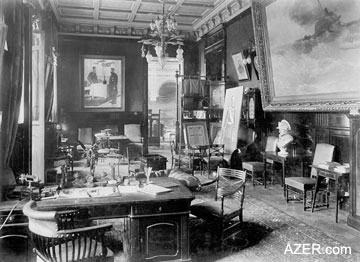  Left: Taghiyev's office on the 2nd floor of his residence
may be visited today. Most of the original furniture has disappeared.
Note the telephone in foreground and painting of Taghiyev meeting
with Iran's Shah at the far end of the room. Photo: Taghiyev's
personal album from the National History Museum (housed in his
residence in Baku). Left: Taghiyev's office on the 2nd floor of his residence
may be visited today. Most of the original furniture has disappeared.
Note the telephone in foreground and painting of Taghiyev meeting
with Iran's Shah at the far end of the room. Photo: Taghiyev's
personal album from the National History Museum (housed in his
residence in Baku).
Anakhanim died when
Taghiyev was still a child. His father remarried and had five
daughters from this marriage. As he could barely earn a living
from his profession, he had difficulty supporting all of these
children. He tried to teach Taghiyev to be a shoemaker, but the
young boy refused, saying that he would rather be a mason or
a builder.
So his father sent him to one of Baku's masons. There he had
to carry construction vats on his shoulders that earned him a
mere six kopeks a day. Nevertheless this meager amount rescued
his family during those hard times when his father was not able
to earn even a single kopek.
Taghi was very pleased to see how hardworking his son was. He
would tell him: "Your salary already supports our family.
May you always have good money, and may you always benefit from
it." Construction work didn't come easy for the young Taghiyev.
He was thin but very hardworking and a quick learner. At age
15, he became a stonemason; at 18 he was already a builder. Soon
he qualified as a constructor-contractor.
Below:
The signature room of the
Taghiyev Residence, the Oriental Room as it appeared in Taghiyev's
day (1910-1920). This ornately decorated room on the second floor
has gilded arches, immense plate glass windows, and is now used
to house part of the collection of the National History Museum.
There is also a "twin" Occidental Room which presently
is not open to the public. Photo: Taghiyev's personal album from
the National History Museum (housed in his residence in Baku).
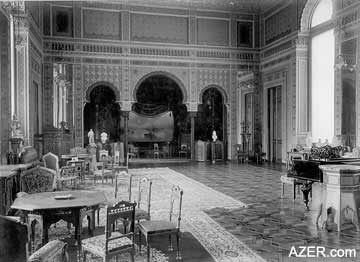  In 1873, along with two partners [the
Sarkis Brothers], Taghiyev rented a plot of land in Bibi-Heybat
[one of the first places where oil was discovered in the Baku
region]. They hired workers, bought the necessary equipment and
started drilling for oil. They drilled and drilled, but with
no success. His partners gave up hope and rarely appeared at
the drilling site. Besides, in the wintertime it was very cold
there and in summer, hot and dusty. In 1873, along with two partners [the
Sarkis Brothers], Taghiyev rented a plot of land in Bibi-Heybat
[one of the first places where oil was discovered in the Baku
region]. They hired workers, bought the necessary equipment and
started drilling for oil. They drilled and drilled, but with
no success. His partners gave up hope and rarely appeared at
the drilling site. Besides, in the wintertime it was very cold
there and in summer, hot and dusty.
Finally his partners decided to sell their shares. Taghiyev purchased
them and became the sole owner of the land. But he didn't lose
hope. He continued drilling and encouraging the workers. Despite
financial difficulties, he paid their salaries on a daily basis.
In the end, his efforts were rewarded with an oil gusher. So
this is how Taghiyev, the son of poor shoemaker Taghi, became
a millionaire.
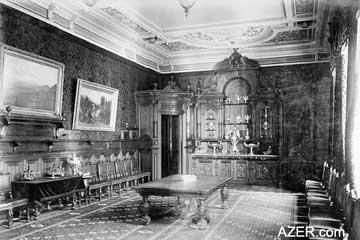  Left: State dining room of Taghiyev's residence. Photo:
Taghiyev's personal album from the National History Museum (housed
in his residence in Baku) Left: State dining room of Taghiyev's residence. Photo:
Taghiyev's personal album from the National History Museum (housed
in his residence in Baku)
Taghiyev also spent a great deal of money for charity projects,
many of them related to education. He sent talented youHis workers
later spoke about how hardworking and patient Taghiyev was. He
seemed to work 24 hours a day.
Even in the worst of times, they said, he remained kind and gentle,
never raising his voice when he spoke with workers. He forgave
their faults and encouraged them to work hard and responsibly.
They said he never refused to help disabled people, orphans and
widows.
Philanthropist
One of the first things Taghiyev did after becoming wealthy was
to surface the road between the city and his oilfield in Bibi-Heybat.
He then extended the road on to the Bibi-Heybat mosque.
Taghiyev also spent a great deal of money for charity projects, many of them related to education. He sent talented young people to study in Moscow, Kazan, St. Petersburg and European
universities. He built schools and gave financial support to
the intelligentsia.
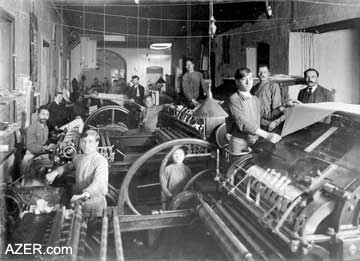  Left (right): Taghiyev, though illiterate himself,
was committed to educating the Azerbaijani public through the
written word. Here is one of the printing houses that he established.
Photos, around 1910. Photo: Taghiyev's personal album from the
National History Museum (housed in his residence in Baku). Left (right): Taghiyev, though illiterate himself,
was committed to educating the Azerbaijani public through the
written word. Here is one of the printing houses that he established.
Photos, around 1910. Photo: Taghiyev's personal album from the
National History Museum (housed in his residence in Baku).
Seyid Jafar, the son
of Azerbaijan's outstanding [progressive] poet Seyid Azim Shirvani,
used to tell this story: "Taghiyev wanted to publish the
first collection of my father's works in Baku at his own expense,
but the clergy and censors wouldn't let him. So Taghiyev sent
the manuscript to Tehran and printed it by lithograph there.
He owned a printing house there, where he published newspapers
and magazines in Azeri [Arabic script] and Russian [Cyrillic].
At first, Taghiyev would send 10 rubles each month to my father;
later he sent 20 rubles. He would often invite my father to Baku,
treat him warmly and then send him back with gifts and money.
But Taghiyev was good to others, not just my father. For example,
the first book of poet Muhammad Hadi was published at the Caspian
Printing House at Taghiyev's expense."
In 1883 Taghiyev built the First Drama Theater in Baku. In 1909
reactionaries set fire to the building, but Taghiyev repaired
it. The following year, the Theater celebrated the 30th Jubilee
of Baku's first theatrical performance. Composer Uzeyir Hajibeyov
wrote a solemn march for the occasion. When Taghiyev entered
the theater, he was greeted with great respect: the orchestra
played the march and the entire audience rose to applaud him.
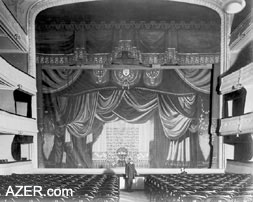  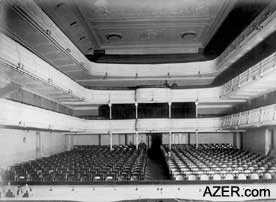
Left: Interior of Baku's first Drama Theater,
built by Taghiyev in 1885. View facing the stage. Right: view from the stage. Taghiyev's personal
album from the National History Museum (housed in his residence
in Baku).
First Muslim Girls'
School
From Professor Hadi Aliyev, I found out that when Alexander III
was in power, Taghiyev asked his permission to build a school
in Baku for Muslim girls. Instruction was to be carried out in
their native language - Azeri. But Alexander refused. When Nicholas
II came to power, Taghiyev sent a very expensive gift to Nicholas'
wife - Alexandra Fyodorovna - and requested her help with this
project. She agreed. In appreciation he named the school after
her - the Russian Muslim Alexandrian Female Boarding School.
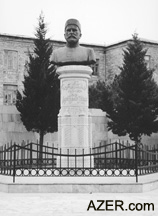  Left: Taghiyev's statue near his grave, in Mardakan
where Taghiyev had his summer home. Left: Taghiyev's statue near his grave, in Mardakan
where Taghiyev had his summer home.
At the same time, he
established an account of 150,000 rubles for the school, with
an annual allotment of 7,500 rubles. Two years later, permission
was granted to build the school. Construction began in 1898 and
was completed in 1900. Altogether the building cost 184,000 rubles.
[The building now houses the National Institute of Manuscripts
and is located at 8 Istiglaliyyat Street (Independence Avenue)
in the heart of Baku.]
That first year, 58 girls were accepted to the school, 35 of
them from poor families. Taghiyev covered their board and clothing
expenses. The school was set up like a closed boarding school;
the girls could visit their parents only once a week, on Fridays
from 10 a.m. to 5 p.m.
Classes started on September 7, 1901, and the grand opening ceremony
took place on September 9. On this occasion, Taghiyev received
many congratulatory telegrams from places like Crimea, Uzbekistan,
St. Petersburg and Kazan. In his speech, Taghiyev conveyed this
wish: "In the future we'll have to turn this female school
into a gymnasium [high school]. This is my cherished dream."
Soon more Muslim female schools opened in other places in the
Russian Empire, including Tiflis [Tbilisi], Kazan, Bashkiria
and Dagestan. By 1915 five girls' schools had been established
in Baku. One of them was in Balakhani, which was a district for
oil workers.
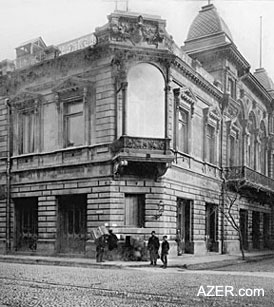  In two years, what had been established
as a four-year school was extended to five years, then six, and
finally - a seminary. Later, two-year training courses were established
for female teachers. In two years, what had been established
as a four-year school was extended to five years, then six, and
finally - a seminary. Later, two-year training courses were established
for female teachers.
Left: Taghiyev's palatial residence, view
from the corner of Alizade and Taghiyev streets. The building
takes up the entire block and is currently being restored. During
the Soviet period, Taghiyev's monogram, center above the large
balcony window, was chipped away. Photo, around 1910. Photo:
Taghiyev's personal album from the National History Museum (housed
in his residence in Baku).
Taghiyev wanted to send his own daughters - Sara and Leyla -
to study at the Smolny Female Institute in St. Petersburg. He
sent all of the necessary documents there only to be refused
on the grounds that he was neither khan nor bey, and thus could
not be considered aristocratic enough for his children to attend.
The institute accepted only the children of counts, grand dukes,
khans, beys and emirs. Then Taghiyev's wife, Sona khanim, presented official documents
saying that she was the daughter of Arablinsky, an outstanding
general of the Russian Army who had been awarded the Golden Gun.
Taghiyev's daughters, Sara and Leyla, were grandchildren of a
general and, therefore, had certain privileges. So, thanks to
the merits of their grandfather, the girls were finally accepted
to the institute.
Translating the
Koran
Since Azerbaijanis didn't know the Arabic language, they had
to learn the Koran by heart, without understanding the meanings
of the words. This was to the advantage of illiterate mollas,
who could interpret the Koran as they wished.
The clergy were against translating the Koran into the Azeri
language. They argued that the content of Koran was holy and
of divine origin and that, therefore, no one had the right to
translate it. Taghiyev decided to send Mirmahammad Karim, one
of his trusted colleagues, to Baghdad to obtain official permission
for the translation. Then he ordered an Arabic font from Leipzig,
Germany and published the first Azeri version of the Koran. Mirmahammad
Karim became the translator.
Taghiyev paid a lot of attention to mosques, since he considered
them to be centers for enlightenment, culture, science and the
moral upbringing of the nation. He built mosques in Azerbaijan
as well as other places. The mosque that he built for Tatars
in St. Petersburg is still functioning.
Since Taghiyev was against nationalism and always tried to promote
friendship between the various nationalities of people living
in Baku, he also built churches for Russians, Georgians and Armenians.
Treasures of Knowledge
Zeynal Salimkhanov: In the evenings, Taghiyev would gather in
his room with his relatives, friends and the important people
of the city. They would chat, exchange news stories and read
newspapers, magazines and books. You could hear Arabic, Persian
and Turkish languages being spoken there, and the newspapers
were in Russian, French, English and German.
Haji Zeynalabdin valued knowledge very much. He tried to understand
everything in depth and didn't tolerate amateurism. He always
regretted not having received an education. Maybe that's why
he encouraged young people to study. Maybe that's why he helped
students, regardless of their nationality or religion.
Generous Nature
Engineer Reza Rezayev told the following story: "In 1919
on the eve of Novruz, we students were collecting money for poor
children and orphans. Along with three other students, I was
given a box in which to collect money. After going to various
offices and stores, we finally went to Haji Zeynalabdin Taghiyev's
place. At first the guard didn't want to let us in. Then I asked
him to tell Taghiyev that I was Alinagha's grandson. Soon the
door opened and we were led to Taghiyev's room.
"Taghiyev looked at me and asked: 'Are you Haji Alinagha's
grandson?'
'Yes,' I replied.
Taghiyev pointed to the box and asked: 'Has anybody already
put money in it?'
'Yes, Haji.'
'Take this box back to school and bring me an empty one.'
We rushed to the gymnasium and brought an empty box. Haji
put a check in it. When we opened the box later, we discovered
that Taghiyev had put given us a 5,000-ruble check, which was
an enormous amount at that time."
The Fish and the
Ring
One day several people met Taghiyev in the street and started
complaining that there was no fresh fish in the city. "Please
help us, for God's sake!"
Haji answered: "Don't worry, soon the smell of fish will
make you sick."
The next day he went down to one of the fishing docks. The manager
told him that the catch had been very bad the last few days.
Taghiyev took a fish that had just been caught, attached his
expensive ring to its tail and threw it back into the sea.
The next day, having heard this news, fishermen swarmed down
to the sea hoping to catch that fish. Just as Taghiyev had anticipated,
the next day, the city was full of an ample amount of fish. But
the ring was never found.
The Old Ax
Taghiyev had an old ax that he had used as a boy when he worked
as a mason. He hung the ax on one of his two safes, opposite
the door, so that every time he opened it, he would see the ax,
remember his hardships and never get spoiled from his wealth.
Wealth Begets Wealth
Sidgi Ruhulla, People's Artist of Azerbaijan Republic, told the
following story: "When Taghiyev worked as a mason, he had
a friend named Murad. Later Taghiyev became a millionaire, but
Murad remained a mason until the end of his life.
"Once the two old friends met each other and started talking.
Murad asked: 'Haji, is it true that you can make 50,000 rubles
at a time?'
"Haji said: 'Murad, I'm going to Paris in 10 days. Come
with me.' Murad hesitated awhile but then in the end agreed.
"They stayed at the Louvre Hotel. Murad thought that he
was dreaming; everything was so magnificent - the curtains, mirrors
and golden items. The service was also very good, which is why
Haji presented all the waitresses and porters with expensive
clothes. This became a real sensation in Paris.
"During breakfast he ordered the best caviar available.
The waiter brought a metallic dish with Taghiyev's name on it:
'H.Z. Taghiyev'.
"Murad couldn't believe his eyes: 'Oh, Haji, your name is
known to the whole world!'
"In the evening, three men came to see Taghiyev. They asked
him not to show up at the auction that would take place the following
day. 'Please, leave Paris and we'll transfer 100,000 rubles to
your account with all the necessary documents. If you come to
the auction, it'll ruin all our plans.'
"Haji agreed. The next day, after receiving the check for
100,000 rubles, Taghiyev and Murad left Paris for Rome. 'You
see, Murad,' Taghiyev said, 'you didn't believe that I could
make 50,000 rubles all at once. But today I got twice that much
for doing nothing. Whoever said that money begets money was right."
Cab Driver in Paris
A Russian engineer recalled meeting Taghiyev after his return
from Paris. "I asked him to share his impressions about
that faraway land. He told me: 'I was riding in a cab, my translator
sitting next to me. We asked the cab driver to make a right turn.
Instead, he turned left. I nudged him slightly with my umbrella,
gesture with my hands that we needed to turn right.
And what do you think he did? He stopped the cab right in the
middle of the street, got out and started screaming and carrying
on. I asked my translator to explain what had made him so angry.
He told me that the driver got insulted when I nudged him with
the umbrella. That if I had had anything to say, I should have
used words. Only then did I understand the situation and, to
tell you the truth, I got embarrassed. In our country, you can
push simple people around and insult them, and they continue
to bow and even say thank you. But not there. If only our people
had such pride, how much happier our nation would be.'
"After that conversation, my respect for Taghiyev grew even
more," the engineer said. "Here was a man who could
not even read five lines of text and who could hardly speak Russian
but when asked to share his impressions about Paris, he didn't
tell me about the glamour of the hotels, restaurants, aristocracy
and theaters. He spoke about pride, dignity and human rights."
Disciplining His
Daughter
Sara, one of Taghiyev's daughters, told the following story:
"Father used to give us five rubles [a significant sum]
every month for everyday expenses. He had a special notebook
where he documented it. We would go to his office, sign and take
the money. I think in this way he wanted to teach us to be responsible.
"Once my sister Leyla, my brother Mahammad and I took a
walk along the sea accompanied by our servants. We went up on
a ship. While the servant was talking to the captain, we went
walking along the deck. Mahammad pointed to one of the portholes
and said: 'Look, the glass is so thick. Nobody can break it!'
"It was as if the devil got into me and made me say, 'No,
I can break it.' So, we made a bet for a box of chocolates. I
grabbed a metal bar and hit the window. Of course, it smashed
into pieces. I was a little scared, but still I was satisfied
because I had won the bet.
"The next day my father called me to his room. 'Who broke
the porthole?' he demanded.
"'I did,' I told him. 'I made a bet with Mahammad.'
"'And who will repair it now?'
I shrugged my shoulders.
"'You're so good at breaking things, but you don't know
who will repair them?' he asked.
"I said that maybe the glass was not so expensive and we
could buy a new one at our own expense.
"'Exactly! Your monthly share will go for the repairs. Your
brother and sister will get their usual five rubles, but not
you! Go to your room!'"
Taghiyev's Tomb
Taghiyev died on September 1, 1924 at his country house in Mardakan
[on the Absheron Peninsula]. On September 4, in accordance with
Taghiyev's wishes, he was buried at the foot of the grave of
Molla Abuturab, Baku's famous "akhund" [singer of prayers].
Molla Abuturab (Mirza Akhund Abu Turabi) was quite an educated
person for his time. He had graduated from the Higher Religion
School in Baghdad. He spoke Arabic, Persian, Turkish and Russian.
His articles often appeared in Azerbaijani newspapers and magazines.
He also wrote several books on philosophy and the history of
religion. One of his famous works was called "Reasons for
the Schism in Islam", in which he was critical that Muslims
had split into two sects - Sunni and Shiite. In general, he was
a person who favored progress and enlightenment.
Taghiyev respected him very much and often followed his advice.
There are several stories that circulate about Taghiyev and the
Molla Abuturab. Taghiyev used to tell this one himself.
"Once on the way to my country house in Mardakan, I saw
Molla Abuturab in his old horse carriage. I stopped my cab and
invited him to join me. He did. We talked about various things.
Then I asked him: 'What do you think? Is it possible that I would
ever lose all my wealth?'
"And the Molla replied: 'Haji, you've made the pilgrimage
to Mecca. You know all about the hardships of the life. If God
wills, He can take away all of your possessions in a split second.
So, set your thoughts on things more eternal.'
"In the 1920s, after my factories, oil fields and palaces
had been confiscated by the Soviet authorities and I was forced
to live in my country house in Mardakan, I often thought about
the Molla's words. It reminded me of the saying, 'Even his little
finger knew more than my head did.' And that's why I want to
be buried at the feet of the Molla."
Taghiyev's Funeral
Crowds of people attended Taghiyev's funeral. The BakRabochy
newspaper published the following obituary: "Z.A. Taghiyev
dies. Zeynal Abdin Taghiyev, one of the greatest industrialists,
financiers and a great philanthropist, died September 1. He was
105."
Philanthropy
If you look through pre-Revolutionary publications, you can see
how many useful and noble things Taghiyev did. He not only helped
his own countrymen, but he also was involved with the intelligentsia
in Iran, India, Egypt and Turkey. For example, when the Hablul
Matin newspaper in India experienced financial difficulties and
had to temporarily cease publication, Taghiyev gave them a significant
amount of money so they could reopen.
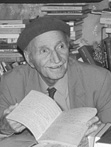  Here is a list of some of Taghiyev's
donations: construction of the Muslim Charity Society in St.
Petersburg - 11,000 rubles; education and rearing of Armenian
orphans - 3,000 rubles; Santa Nina Russian Female School - 5,000
rubles; repair of the mosque in Astrakhan - 5,000 rubles; Saadat
School - 5,000 rubles; construction of Madraseh school in Tehran
- 55,000 rubles; repair of Safa school - 500 rubles; and for
a commercial school and the education of Muslim children - 50,000
rubles. The list goes on and on. Here is a list of some of Taghiyev's
donations: construction of the Muslim Charity Society in St.
Petersburg - 11,000 rubles; education and rearing of Armenian
orphans - 3,000 rubles; Santa Nina Russian Female School - 5,000
rubles; repair of the mosque in Astrakhan - 5,000 rubles; Saadat
School - 5,000 rubles; construction of Madraseh school in Tehran
- 55,000 rubles; repair of Safa school - 500 rubles; and for
a commercial school and the education of Muslim children - 50,000
rubles. The list goes on and on.
Above: Manaf Suleymanov
From Manaf Suleymanov's book, "What I Heard, What I Read,
What I Saw," published in 1996 by Azerbaijan Publishing
House and translated here by AI staff member Arzu Aghayeva.
Naila Valikhani, Director of the National History Museum housed
in the Taghiyev residence, helped to provide rare photos from
Taghiyev's personal album.
_
Back to Index
AI 10.2 (Summer 2002)
AI Home
| Magazine
Choice
| Topics
| AI Store | Contact us
Other Web sites
created by Azerbaijan International
AZgallery.org | AZERI.org | HAJIBEYOV.com
|











